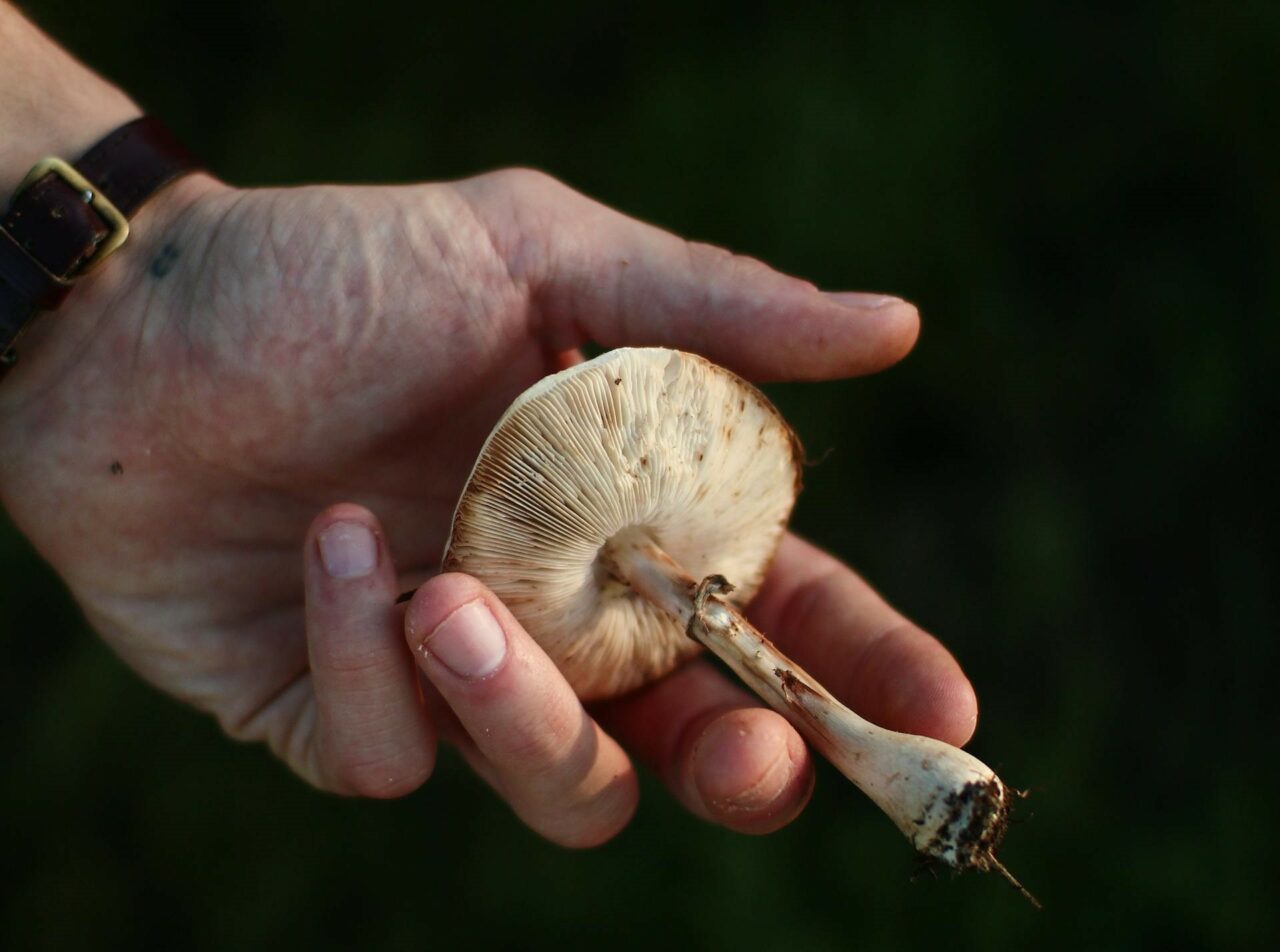Psilocybin mushrooms are a traditional psychedelic that operate as a serotonin 5-HT2A receptor agonist, similar to LSD. Current research is exploring their use in psilocybin-assisted therapy for various mental health disorders, such as emotional distress related to major depression, anxiety, cluster headaches, and migraines.
To understand how shrooms can help with these conditions, it’s important to examine how they are metabolized in the body. By doing so, researchers and users can better understand how the active compound produces psychological and therapeutic benefits. This article provides a basic overview of psilocybin’s pharmacology and pharmacokinetics.
[toc]
Key Takeaways:
- When consumed orally, half of the psychedelic fungi are absorbed and distributed throughout the body.
- The fungi compound is dephosphorylated by the enzyme alkaline phosphatase, primarily in the liver.
- About 3.4% of the compound is excreted in its original form within 24 hours, with the majority being eliminated as a stable metabolite.
What is Pharmacokinetics?
Pharmacokinetics (PK) is the study of how the body processes substances, such as drugs, once they are ingested. It’s closely related to, but distinct from, pharmacodynamics, which explores how a compound interacts with the body. PK focuses on four main aspects: absorption, distribution, metabolism, and excretion (ADME).
This understanding enables healthcare professionals to prescribe the most effective medications with the least risk. It also helps them personalize treatments based on each patient’s unique physiology and lifestyle.
Pharmacokinetics and Psilocybin: The Connection
The primary active compounds in certain magic mushroom species, psilocybin and psilocin, have attracted significant interest from researchers and users alike. Pharmacokinetics helps to understand how these mushroom compounds are processed by the body and their potential impacts, both medicinal and recreational.
These compounds, commonly referred to as “magic,” “psychedelic,” “medicinal,” or “sacred,” are found in fungi that are typically ingested. The Varieties of mushrooms, their place of origin, size, the conditions in which they grow and get dried, as well as their age, can cause substantial differences in their concentrations.
While these types of mushrooms naturally exist in the wild, scientists have devised techniques to create them in a laboratory setting. Both natural and lab-made versions display low toxicity levels, although minor side effects like nausea or vomiting may happen.
Despite these physical reactions, the compounds present in these mushrooms have demonstrated potential therapeutic advantages due to their safety profile and non-addictive properties. These benefits have prompted researchers to explore their application in psychotherapy, specifically in treating anxiety and depression.
Understanding the 4 Stages of Pharmacokinetics
Psilocybin, the compound found in these mushrooms, is inactive in its original state and acts as a prodrug, converting into its active form, psilocin. Enzymes such as alkaline phosphatase facilitate this transformation, enabling psilocin to be absorbed and disseminated within the body, reaching various tissues. However, post oral intake, psilocybin is not traceable in the circulatory system, feces, or urine.
Absorption
Absorption refers to the process through which the compound enters the bloodstream from the point of administration. It determines the speed and effectiveness with which the compound reaches its target, such as the plasma. Oral intake is the most common administration method. Inhalation has been tried, but it’s not as effective as consumption through the mouth.
The absorption process also entails the release of the compound from the dosage form during oral ingestion. Factors like a delay in the throat or esophagus can affect this, potentially slowing down results or causing discomfort. Once the compound reaches the stomach, the acidic environment may start to break it down before it enters the bloodstream.
Research on animals suggests that only around 50% of orally administered psychedelics are absorbed and distributed within the body.
Factors Affecting the Absorption Process
Numerous factors can influence the absorption process, leading to differences in the onset, intensity, and duration:
- Stomach Contents: The presence of food in the stomach can delay the process as it slows down the onset of effects. Faster absorption is possible on an empty stomach. class=”wp-block-heading”>Dissemination
- Body Fat: Substances might build up in adipose tissues, possibly prolonging their effects.
- Age: Metabolic functions and body composition often vary with age.
- Zero-Order Kinetics: The substance is expelled at a constant rate, regardless of its concentration.
- First-Order Kinetics: The elimination rate is directly proportional to the drug’s concentration.
The term “Distribution” denotes the dispersion of psilocin within the body once it enters the bloodstream. Due to its lipophilic nature, psilocin can penetrate the blood-brain barrier and access the central nervous system.
Various factors like the product’s size, polarity, and protein-binding capacity, as well as individual physiological conditions—like hydration status and body composition—significantly affect this process.
The goal is to reach an adequate concentration at the target site. To be effective, the product should arrive at the intended location, defined by the volume of distribution, and remain unbound to proteins, allowing it to actively engage with its receptor.
What Factors Affect the Distribution Process?
Several elements can impact the distribution process:
Usually, the effects become noticeable within 20-40 minutes after ingestion, reaching a peak at around 80-100 minutes. The effects of magic mushrooms typically persist for a period of 4-6 hours.
How Does the Brain Absorb the Substance?
An early experimental study on two species showed that the order of its binding affinity is 5HT2A > 5HT1A > 5HT2B [23]. It also binds to dopamine D1, 5HT1E, 5HT5A, 5HT7, 5HT6, D3, 5HT2C, and 5HT1B receptors.
It acts as a partial agonist at the 5HT2A receptor, with an efficacy of about 40%. Its psychedelic effects are attributed to its partial agonist activity at 5HT1A autoreceptors.
The elevation in mood and psychotomimetic experiences could be due to the observed correlation between increased dopamine levels and sensations of depersonalization and euphoria. Hallucinogens work by modifying neurochemistry and receptor activity. They enhance 5HT2A agonist activity by boosting BDNF synthesis in the hippocampus, which promotes neurogenesis and reduces conditioned fear-related behaviors.
Elimination
Elimination refers to the method by which the
The body expels substances chiefly through the kidneys, and to some extent through the lungs, skin, or gastrointestinal tract. In the case of kidneys, they filter out a naturally occurring psychedelic drug either in the glomerulus or secret it in the tubules, a process further complicated by some reabsorption.
The primary compound has an average half-life of 160 minutes, in contrast to psilocin’s 50 minutes. Animal research indicates that this compound is mainly excreted via urine, accounting for about 65% within 8 hours post intake. Even after consumption, trace amounts of the substance can be detected in bile and feces.
Within a 24 hour period, around 3.4% of the substance is eliminated from the human body in its original form, while the larger portion is expelled as psilocin-O-glucuronide, a more stable metabolite. This stability allows for the compound’s detection in urine samples over extended periods.
Substance excretion primarily follows two methods:
Most psychedelic drugs adhere to the first-order kinetics method, achieving stable concentrations after four to five half-lives. Complete elimination also occurs after four to five half-lives.
Discover Our Range of Psychedelic Mushrooms
The metabolic process differs greatly among different types of mushrooms. Purchasing from reliable online vendors like Powerful Magic Mushrooms Canada helps you avoid the risk of accidental intake of poisonous mushrooms. For instance, certain types like Agaric mushrooms can cause severe and undesirable effects. Hence, it’s crucial to source your magic mushrooms from trusted dispensaries, as opposed to unreliable street vendors or foraging in the wild.
| Feature | Enigma | Full Moon Party | Gold Member | |
| Strain Type | Psilocybe Cubensis OMNI | Psilocybe cubensis (Thai Koh Samui) | Psilocybe cubensis | |
| Potency | Exceptionally high; 3.8% tryptamine content | Moderate to high potency | High potency | |
| Visual Characteristics | Resembles a blob or | Resembles a cauliflower or brain structure | Displays typical cubensis characteristics; moderate in size | Thick, white stems; caps are a golden caramel color; visible blue discoloration |
| Effects | Considered the most potent; yields intense effects | Potent mental stimulation; onset is delayed but visuals are prominent | Extremely vivid visuals and feelings of euphoria |
Online Guide to Psilocybin Mushroom Usage
It’s crucial for medical professionals, researchers, and users to grasp the pharmacokinetics of shrooms. This understanding allows you to make well-informed decisions about dosage and timing, reducing potential risks.
Discover your perfect psychedelic experience at Powerful Magic Mushrooms Canada. Whether you’re in search of a peaceful journey or a deeper exploration, our wide array of products are tailored to meet your specific desires. You can trust in our premium, safe, and quality-assured shrooms, eliminating worries about unreliable sources or poisonous mushrooms.
Enjoy the best magic mushrooms Canada has to offer, and take your psychedelic adventure to new heights.
Frequently Asked Questions
Are there known interactions between shrooms and other drugs?
Our products may interact with specific medications, particularly those that affect serotonin levels, such as SSRIs (Selective Serotonin Reuptake Inhibitors). SSRIs and SNRIs (Serotonin and Norepinephrine Reuptake Inhibitors) generally reduce the effects, unlike non-serotonergic antidepressants. This reduced effect can continue for up to three months after discontinuing the use of the antidepressant.
Do all psychedelics follow the same pathway as psilocybin?
No, each psychedelic substance has a unique structure that requires distinct metabolic processes to become active, and they attach to different receptors in the body. The method of administration also affects each psychedelic’s absorption. While the primary principles of absorption, metabolism, and distribution are consistent, the specific pathways and impacts vary for each substance.
Does the form of the shroom affect the pharmacokinetics?
Yes, the form (whether fresh, powdered, or dried mushrooms) can influence the absorption rate. For example, powdered forms may be absorbed quicker than whole dried ones due to faster dissolution.
Further Reading:





